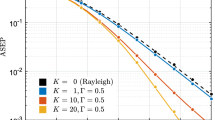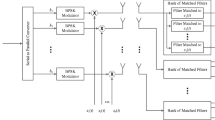Abstract
In this paper, a convenient signaling scheme, called orthogonal on–off BPSK (O3BPSK), along with a simple one-shot linear decorrelating detector (LDD) and a whitening Rake bank, is proposed for near–far resistant detection in asynchronous DS/CDMA systems. Based on the maximum multi-path spreading delay, a minimum duration of “off” is suggested, during which the temporally adjacent bits (TABs) that contain multi-user interference (MUI) and inter-symbol interference (ISI) from different users at the receiver are decoupled. The O3BPSK signaling scheme is combined with the whitening Rake receiver to preserve multi-path diversity gain in multi-path fading CDMA channels. The scheme offers low complexity, no detection delay, near–far resistance, and compensation for fading channels.
Similar content being viewed by others
References
Wu Q. (1999) Performance of optimum transmitter power control in CDMA. IEEE Transactions on Vehicular Technology 48(2): 571–575. doi:10.1109/25.752582.
Chen B.S., Lee B.K., Chen S.K. (2005) Adaptive power control of cellular CDMA systems via the optimal predictive model. IEEE Transactions on Wireless Communication 4(4): 1914–1927. doi:10.1109/TWC.2005.850287.
Verdú S. (1998) Multiuser Detection. Cambridge University Press, Cambridge, UK
Verdú, S. (1984). Optimum Multi-user Signal Detection, Ph.D. Dissertation, Department of Elec. Compu. Eng., Univ., Illinois, Urbana-Champaign.
Verdú S. (1986) Minimum probability of error for asynchronous Gaussian multiple-access channels. IEEE Transactions on Information Theory 32(1): 85–96. doi:10.1109/TIT.1986.1057121.
Verdú S. (1986) Optimum multiuser asymptotic efficiency. IEEE Transactions on Communications 34(9): 890–897. doi:10.1109/TCOM.1986.1096645.
Varanashi M.K., Aazhang B. (1990) Multistage detection in asynchronous code-division multiple-access communications. IEEE Transactions on Communication 38(4): 509–519. doi:10.1109/26.52662.
Lupas R., Verdú S. (1989) Linear multiuser detectors for synchronous code-division multiple-access channels. IEEE Transactions Information Theory 35(1): 123–136. doi:10.1109/18.42183.
Lupas R., Verdú S. (1990) Near-far resistance of multiuser detector in asynchronous channels. IEEE Transactions Communication 38(4): 496–508. doi:10.1109/26.52661.
Xie Z., Short R.T., Rushforth C.K. (1990) A family of suboptimum detectors for coherent multiuser communications. IEEE Journal on Selected Areas Communication 8(4): 683–690. doi:10.1109/49.54464.
Lee S.K., Kim S.R. (2002) A one-shot LDD with pre-SDC/post-MRC for random CDMA over asynchronous Rayleigh channels. IEEE Journal on Selected Areas Communication 20(2): 257–263. doi:10.1109/49.983339.
Sessler G.M.A., Jondral F.K. (2005) Low complexity polynomial expansion multiuser detector for CDMA systems. IEEE Transactions on Vehicular Technology 54(4): 1379–1391. doi:10.1109/TVT.2005.851322.
Ozdemir O., Torlak M. (2004) Reduced-rank RAKE receivers for asynchronous CDMA signals. Signal Processing 84(8): 1385–1394. doi:10.1016/j.sigpro.2004.05.024.
Wijayasuriya, S. S. H., Norton, G. H., & McGeehan, J. P. (1992). A near-far resistant sliding window decorrelating algorithm for multi-user detectors in DS-CDMA systems. In Proceedings of IEEE Global Telecommunications Conference, Globecom’92(Vol. 3, pp. 1331–1338). New York, USA.
Zheng F.C., Barton S.K. (1995) Near-far resistant detection of CDMA signals via isolation bit insertion. IEEE Transactions on Communication 43(234): 1313–1317
Zheng, F. C., & Barton, S. K. (1994). A new signaling scheme for one-shot near-far resistant detection in DS/CDMA. In Proceedings IEEE Personal, Indoor and Mobile Radio Communications, PIMRC’ 94 (pp. 194–198). The Hague, The Netherlands, Sept. 19–22.
Zheng F.C., Barton S.K. (1998) Orthogonal on–off BPSK: a convenient signaling scheme for near–far resistant detection in DS/CDMA. IEEE Transactions on Vehicular Technology 47(3): 969–976. doi:10.1109/25.704851.
Wen J.H., Wen C.K., Wu H.T. (2003) Performance analysis of O3BPSK LDD for asynchronous CDMA systems in the presence of synchronization errors. IEEE Transactions of Vehicular Technology 52(4): 958–969
Zheng, F. C., & Barton, S. K. (1995). One-shot near-far resistant CDMA detection in multipath fading channels—an O3BPSK based system. In Proceedings IEEE 45th Vehicular Technology Conference, VTC ’95 (Vol. 1, pp. 489–493). Chicago, IL, USA, July 1995.
Zvonar Z., Brady D. (1995) Suboptimal multiuser detector for frequency-selective Rayleigh fading synchronous CDMA channels. IEEE Transactions on Communication 43(234): 154–157
Proakis, J. G. (2001). Digital Communications (4th Edn.). New York: McGraw-Hill.
Lee, W. C. Y. “Overview of cellular CDMA,” IEEE Transactions on Vehicular Technology, 40(2), 291–302. doi:10.1109/25.289410.
Author information
Authors and Affiliations
Corresponding author
Rights and permissions
About this article
Cite this article
Cheng, CH., Lin, JY., Wen, CK. et al. O3BPSK-based Linear Decorrelating Detector for Asynchronous DS/CDMA Systems over Frequency-Selective Rayleigh Fading Channels. Wireless Pers Commun 48, 311–325 (2009). https://doi.org/10.1007/s11277-008-9524-z
Received:
Accepted:
Published:
Issue Date:
DOI: https://doi.org/10.1007/s11277-008-9524-z




